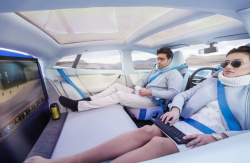
— Senators John Thune (R-S.D.) and Gary Peters (D-Mich.) have introduced their vision of driverless car legislation that would overhaul federal laws created at a time when the thought of a driverless car would have been science fiction.
The government is good about coming up with all kinds of long names to describe new legislative proposals, and this one is no different: the “American Vision for Safer Transportation Through Advancement of Revolutionary Technologies (AV START) Act.”
The language for what to call driverless vehicles changes based on the weight of a vehicle and the "Levels" of the technology, Levels created by SAE International, formally called the Society of Automotive Engineers.
A "highly automated vehicle" (HAV) is defined as a vehicle with a gross weight of 10,000 pounds or less (which excludes most heavy trucks and buses), and equipped with a Level 3, 4 or 5 automated driving system.
A Level 3 vehicle can drive itself in some circumstances, but requires a human driver be present to take over if needed. A Level 4 vehicle can drive itself in some circumstances, but does not need a human driver to take over. A Level 5 vehicle can drive itself in all circumstances and does not need a human driver to take over.
Then there is a "dedicated highly automated vehicle" (DHAV), defined as a highly automated vehicle equipped with a Level 4 or 5 system that is operated at those levels for all trips, making the car a truly driverless vehicle.
The government is pushing driverless technology because statistics show more than 90 percent of crash fatalities in 2015 were attributed to errors made by humans. Safety regulators say those deaths can only be erased by getting humans away from the steering wheels and pedals.
The new proposal (S. 1885) will direct the Department of Transportation (DOT) to update federal safety standards to remove language now seen as ancient and a hindrance to the evolution of motorized travel.
Some sections of the AV START Act are identical to the language in the SELF DRIVE Act proposed by the U.S. House, and as with the House version, the AV Start Act would open the roads to driverless technology by skipping safety standards that traditional automakers must meet.
Furthermore, the amount of changes to wording in current federal standards will need to be completely changed to remove references to human drivers. Based on today's regulations, Thune and Peters says true driverless cars wouldn't be allowed anywhere near a highway, something that has to change to get drivers away from the wheels.
The Act seeks to expand the authority of the DOT to make sure up to 100,000 driverless cars per manufacturer are safe for the roads three years after the proposal becomes law.
Wording in the AV START Act indicates changes that would be available for Americans with disabilities to allow those consumers to travel in self-driving cars without relying on others to do the driving. Thune and Peters say if the Act becomes law, those with disabilities won't be denied a license to drive a self-driving car on the basis of a disability.
The Senate proposal will require manufacturers to submit safety evaluations to the government concerning cybersecurity, crashworthiness and safety, unless the vehicles are over 10,000 lbs. As for big trucks and buses, those vehicles won't be affected by the AV START Act, but the DOT is expected to work toward a day when those vehicles will be fully automated.
The Act also discusses something most automakers dread doing, specifically sharing data between companies. Each manufacturer keeps their business private and even the thought of sharing data with competitors isn't a popular idea. But the AV START Act wants a committee of experts to create standards that would apply to the recording, access and sharing of driverless car data.
Additionally, the Act wants guidelines to educate consumers about how to use driverless technology, especially about the limitations of the technology and the difference between driver assistance technology and true driverless car technology.
The Senate Committee on Commerce, Science, and Transportation will take up the matter on October 4, 2017.




